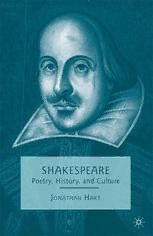
Shakespeare: Poetry, History, and Culture PDF
Preview Shakespeare: Poetry, History, and Culture
Shakespeare This page intentionally left blank Shakespeare Poetry, History, and Culture Jonathan Hart shakespeare Copyright © Jonathan Hart, 2009. Softcover reprint of the hardcover 1st edition 2009 978-0-230-61677-6 All rights reserved. First published in 2009 by PALGRAVE MACMILLAN® in the United States—a division of St. Martin’s Press LLC, 175 Fifth Avenue, New York, NY 10010 Where this book is distributed in the UK, Europe and the rest of the world, this is by Palgrave Macmillan, a division of Macmillan Publishers Limited, registered in England, company number 785998, of Houndmills, Basingstoke, Hampshire RG21 6XS. Palgrave Macmillan is the global academic imprint of the above companies and has companies and representatives throughout the world. Palgrave® and Macmillan® are registered trademarks in the United States, the United Kingdom, Europe and other countries. ISBN 978-1-349-38020-6 ISBN 978-0-230-10398-6 (eBook) DOI 10.1057/9780230103986 Library of Congress Cataloging-in-Publication Data Hart, Jonathan Locke, 1956- Shakespeare : poetry, culture and history / Jonathan Hart. p. cm. ISBN 978-1-4039-6188-4 (alk. paper) 1. Shakespeare, William, 1564-1616—Criticism and interpretation. I. Title. PR2989.H267 2009 822.3'3—dc22 2009015906 A catalogue record of the book is available from the British Library. Design by Scribe Inc. First edition: December 2009 10 9 8 7 6 5 4 3 2 1 For Anne Barton This page intentionally left blank Contents Preface and Acknowledgments ix Introduction 1 I Poetry 15 1 Venus and Adonis 17 2 The Rape of Lucrece 29 3 The Sonnets 45 II Culture and History 71 4 Barbarism and Its Contexts 73 5 Shakespeare’s Representation of History 89 6 Shakespeare’s Italy and England 99 7 Some Questions of Gender in the Second Tetralogy 121 8 Henry V 173 9 Henry VIII 193 Conclusion 205 Notes 211 Index 253 This page intentionally left blank Preface and Acknowledgments This is a book for general readers, students, and scholars in the field. As a result, I have written the volume in what I hope is an accessible way without sacrificing attention to detail. Another aspect of this study is that it is the work of someone who has published poetry, criticism, and history over a long period. I see criticism and history as arts as well as matters of science. That is perhaps why I have not rushed to bring this book together in a single argument but have left it, perhaps neglectfully, over decades. I have tried to add some notes to allow the reader to see what was done in the field after the writing that seems most relevant to the topic at hand. The tension among the poet, the critic, and the historian is probably in keep- ing with those strands in the work under consideration. Shakespeare, however, is an exceptional case. My debt is to the text, the trace before me, of a remarkable artist, practical and theoretical, of the theatre and poetry. He can be Milton’s poet of nature and someone who calls attention to theatricality, as Hamlet and the Chorus in Henry V do so well. Shakespeare was a poet and a working actor, playwright, and sharer in a theatre company, so it is important, as John Barton has shown, to think also of the text as a score for living theatre. How, for instance, does an actor convey irony? I thank John Barton and others who write for and direct in the theatre for the productions I have seen or workshops given or books written from this point of view. Earlier parts of some of the book have appeared in journals and collections in Europe and the United States, but some chapters, like those on representing history, gender, and barbarism, appear here in print for the first time even if they were first created some time ago. Some of these parts I wanted to let sit so I could think about whether my approach made sense. Often, my way in was to the evidence of the text itself, providing some context along the way. Some were in areas of controversy, and I did not want to be so caught up in the moment that I would bring more blindness than insight to the matter at hand. After a long time, I have decided to let this method stand, of working from Shakespeare’s text, as fluid as that might be, and looking outward when the work suggests that. As Shakespeare’s texts are matters of editorial controversy themselves, with variants in spelling, lines, and scenes in places, I have not attempted to standardize any
